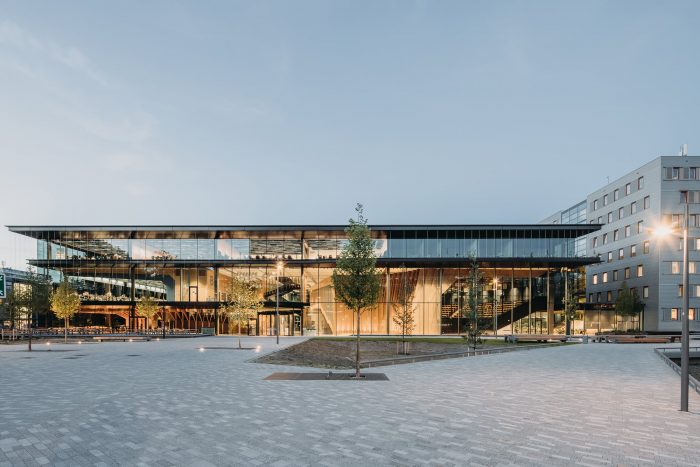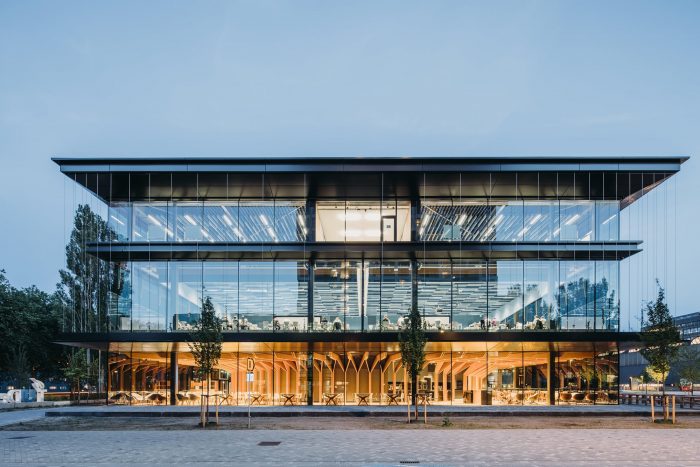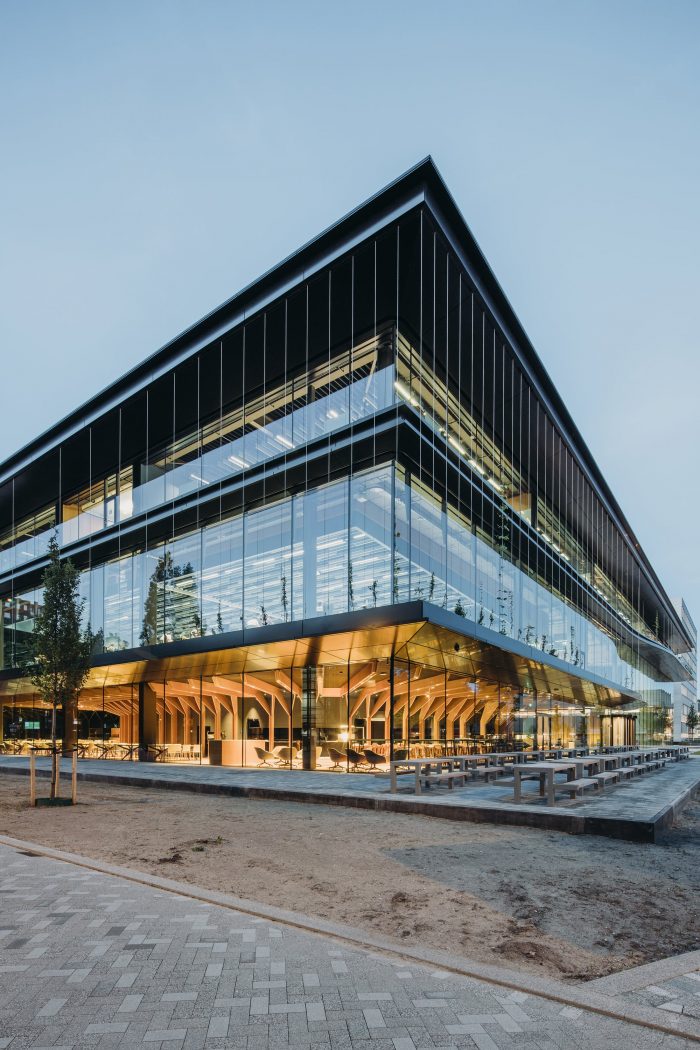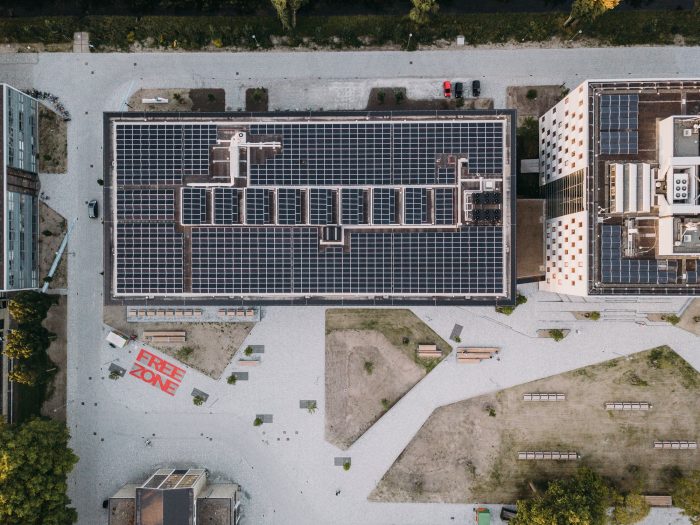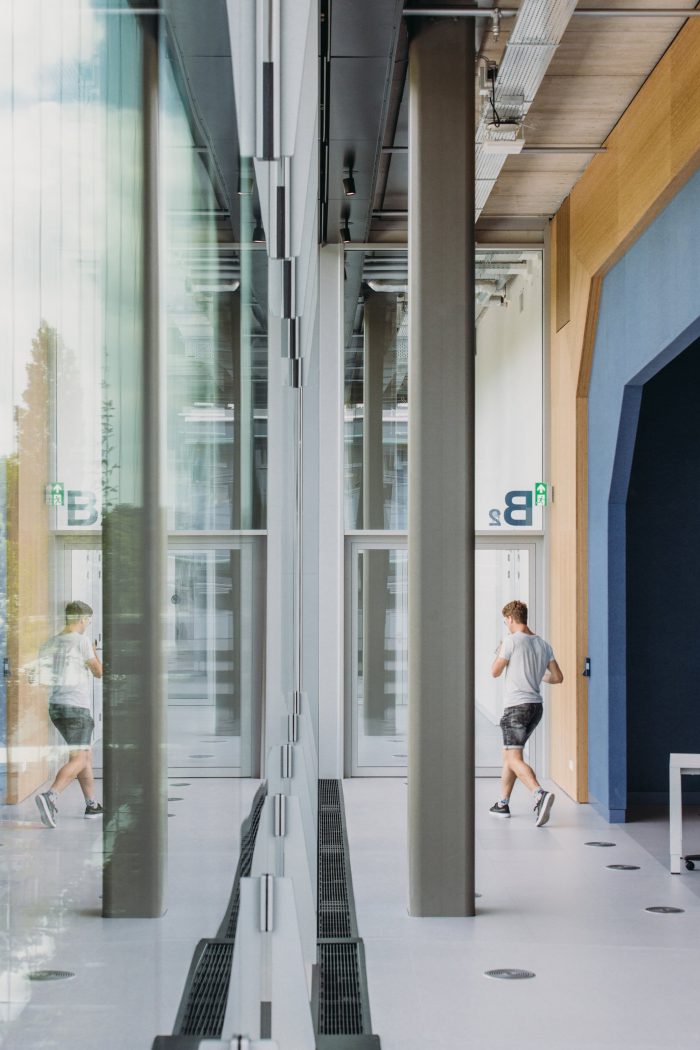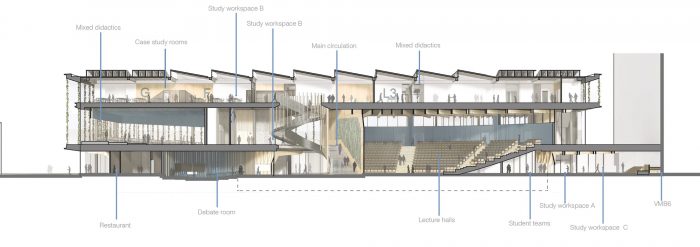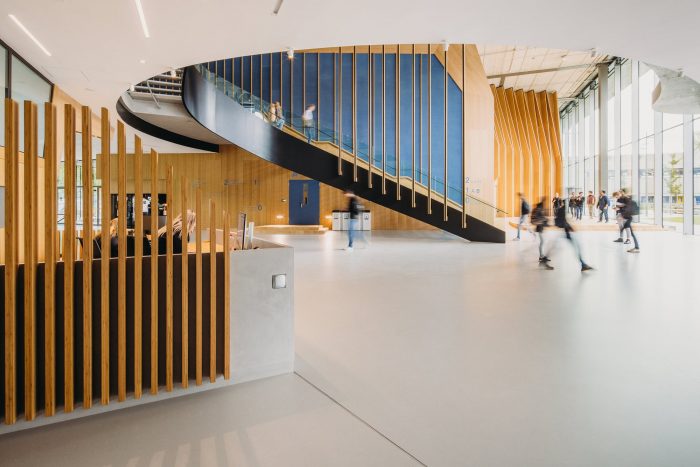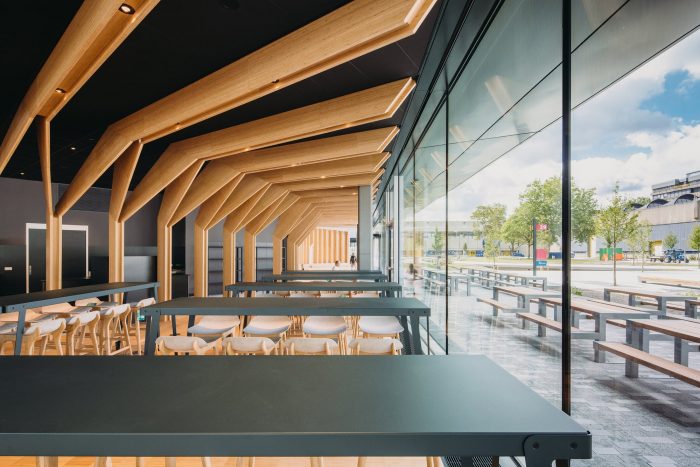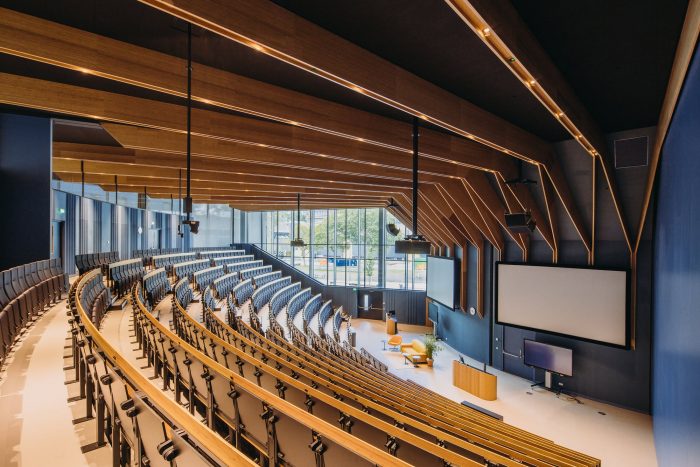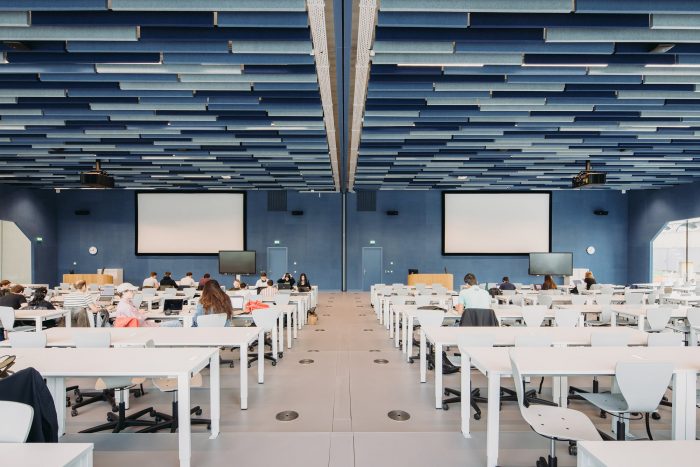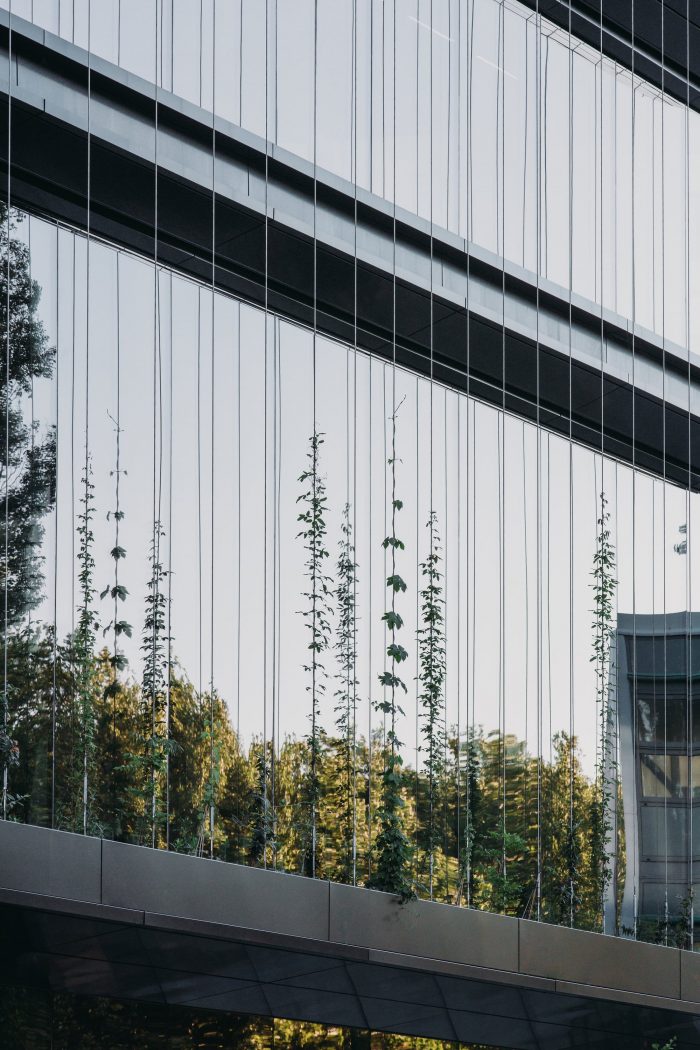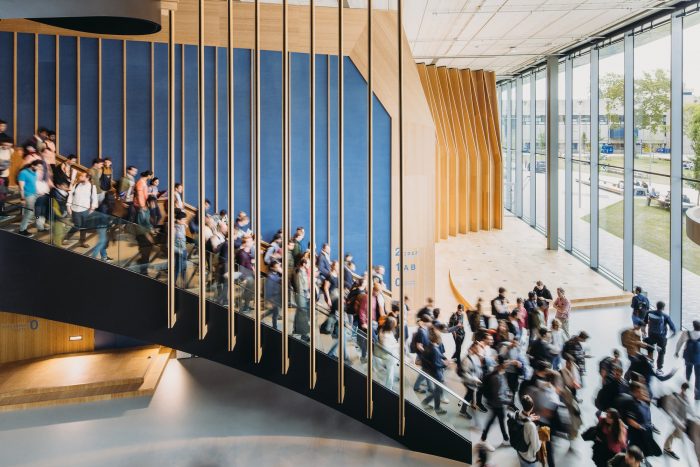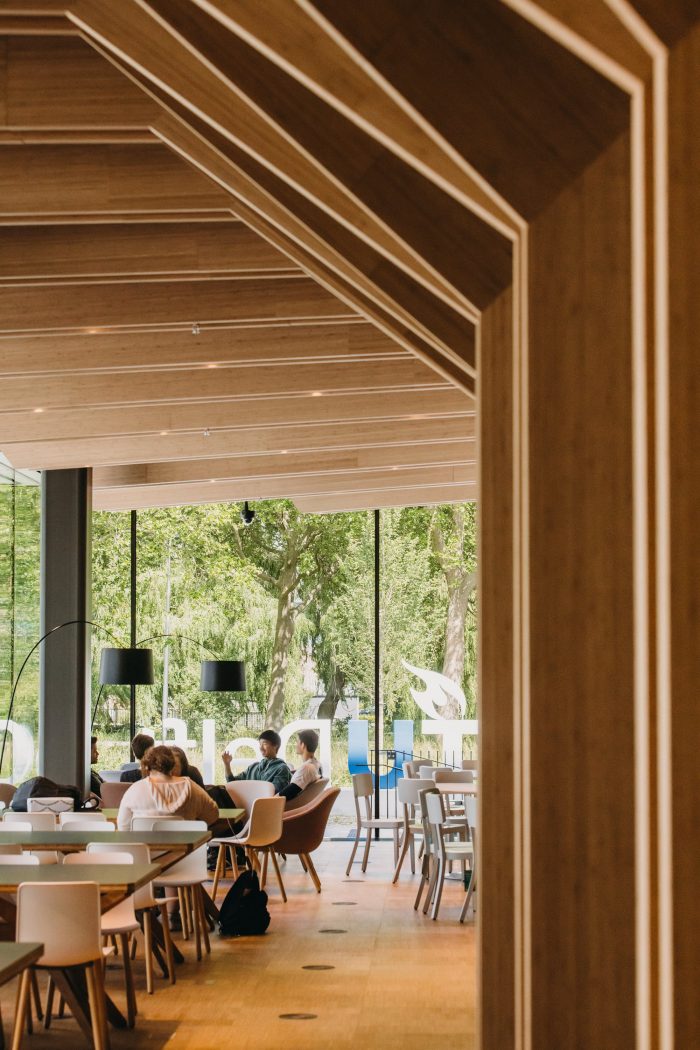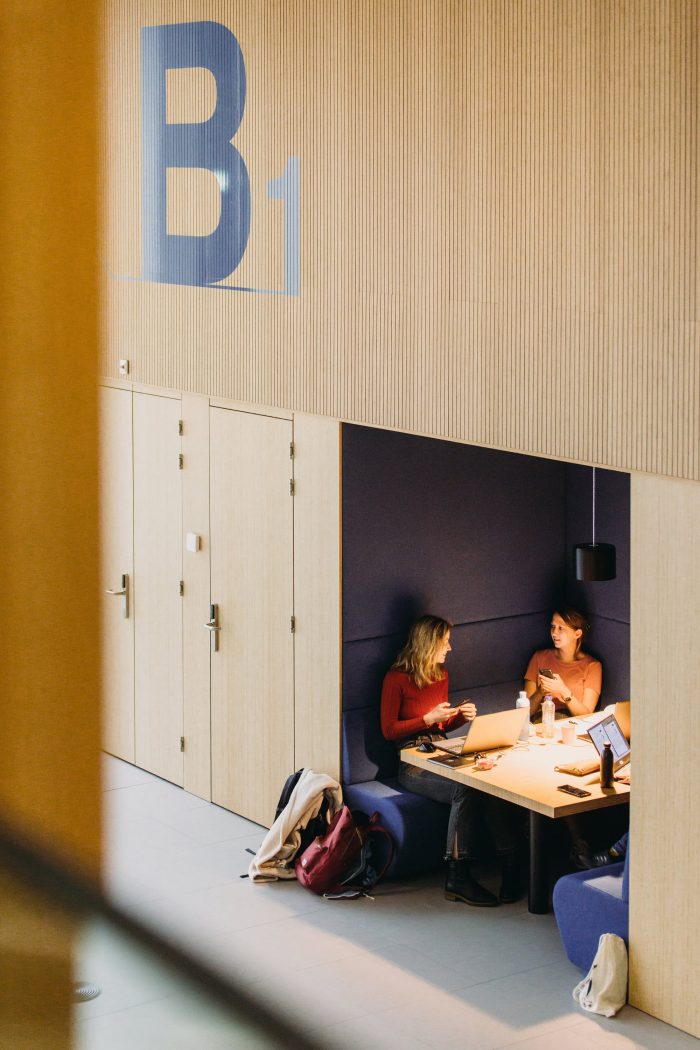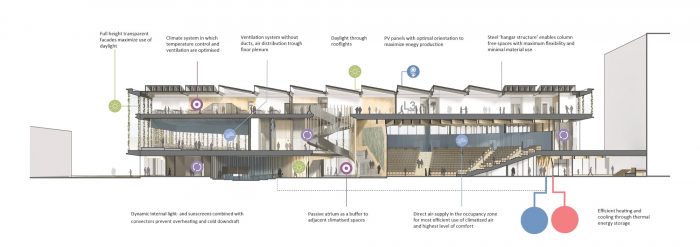Echo是一座能源发电的院际大楼,它提供了多种多样的教学室,以满足大学教学方法和学习方式的多样性。作为代尔夫特理工大学最可持续的建筑,Echo为该大学到2030年实现完全可持续校园的目标做出了贡献。
Echo is an energy-generating interfaculty building that offers a wide variety of teaching rooms to cater to the diversity of teaching methods and study styles at the university. As the most sustainable building at the TU Delft, Echo is contributing to the university’s ambitions to operate a fully sustainable campus by 2030.
对于Echo,UNStudio与Arup和BBN合作,创造了一个设计,完全支持不同的教育类型和教学方法的能源产生的建筑,其中适应性和用户的福祉是核心。
一个健康的校园建筑–为了人类和地球。1200块太阳能电池板、智能安装、良好的绝缘、以及一个热能和冷能储存系统确保Echo能够提供超过其日常运作所需的能源。这包括与用户有关的能源,如笔记本电脑、照明和餐饮的电力消耗。建筑中使用的90%的家具也被重新使用。
For Echo, UNStudio, in collaboration with Arup and BBN, created a design that fully supports different educational typologies and teaching methods with an energy-generating building in which adaptability and the wellbeing of the user are central.
A healthy campus building – for people and the planet. 1200 solar panels, smart installations, good insulation, and a heat and cold storage system ensure that Echo will be able to provide more energy than it requires for its daily operations. This includes user-related energy, such as electricity consumption for laptops, lighting, and catering. 90% of the furniture used in the building has also been reused.
透明度对Echo的设计至关重要。它不仅确保了建筑内最大限度的日光(众所周知,这对用户的健康有好处,同时也减少了对人工照明的需求),它还创造了一个与更广泛的校园和周围自然的视觉联系。因此,避免了用户的封闭式 “机构 “体验,而建筑的开放性和公共性连接了校园的两边,为教师和学生提供了一个明亮、振奋和欢迎的环境。
Transparency was essential to the design of Echo. It not only ensures maximum daylight inside the building (known to have health benefits for the users, but also reduces the need for artificial lighting), it also creates a visual connection to the wider campus and to surrounding nature. As such, a closed-in, ‘institutional’ experience for the users is avoided, while the open and public character of the building connects the two sides of the campus and provides a bright, uplifting, and welcoming environment for faculty and students alike.
然而,为了避免热量增加,也必须防止过多的阳光穿透。建筑物的过热是通过防晒和玻璃的低太阳穿透系数的组合来防止的。此外,深深的水平铝制遮阳篷将多余的太阳热量挡在外面。这些雨篷通过电缆相互连接,攀爬的植物沿着电缆形成一个微妙的绿色外墙,过滤日光。
However, to avoid heat gain, it is also essential to prevent excess sunlight penetration. Overheating of the building is prevented by a combination of sun protection and the low solar penetration factor of the glass. In addition, the deep horizontal aluminum awnings keep out excess solar heat. These canopies are interconnected by cables along which climbing plants form a subtle green facade that filters daylight.
为了确保建筑内空气的清洁,在空心板上安装了一个羽绒地板。在这里,新鲜空气被从地板上抽上来,而不是从上面抽下来,从而避免了房间里的循环。如果将来房间的布局发生变化,这个系统的通风口以及计算机地板的安装都可以很容易地重新定位。
不仅对建筑材料的环境影响给予了极大的关注,而且建筑的设计也尽可能地遵循了循环性原则。使用大网格尺寸的大型门户结构,柱子沿着建筑的边缘运行,创造出大跨度的无柱空间。钢桁架有标准尺寸,可以拆卸,以便在建筑寿命结束后可以在其他地方重新使用。空心楼板也可以在未来重新使用。
To ensure clean air in the building, a plenum floor is installed above hollow-core slabs. Here fresh air is pumped up from the floor, rather than down from above, thus avoiding circulation around the room. The vents for this system, along with the computer floor installation, can easily be relocated, should the layouts of the rooms change in the future.
Not only has a great deal of attention been paid to the environmental impact of the materials used in the construction, but the building has been designed as much as possible according to principles of circularity. Using large portal constructions with large grid sizes, the columns run along the edge of the building, creating column-free spaces with large spans. The steel trusses have standard sizes and can be dismantled so that they can be reused elsewhere after the lifespan of the building. The hollow-core slabs can also be reused in the future.
一个刺激运动和协作的建筑。Echo是一座具有多功能空间的教育建筑,超越了目前的学习环境。该设计支持 “一切皆有可能 “的当代文化,在这种文化中,中间的空间也是非常重要的,身体的运动也得到了刺激。因此,Echo也为非结构化的时间提供了空间:各种思考、灵感和交流的平台。
A building that stimulates movement and collaboration. Echo is an education building with multifunctional spaces that transcends current learning environments. The design supports the contemporary culture of ‘Everything Anywhere’, where the in-between spaces are also of great importance and physical movement is stimulated. Echo therefore also provides space for unstructured time: a variety of platforms for reflection, inspiration, and communication.
室内为参观者提供了一个热烈的欢迎。在特定的位置,竹子的肋骨沿着天花板延伸,形成设计的一个组成部分。竹子的工艺外观和感觉延伸到中央楼梯周围,以一种姿态将学习和合作空间连接成一个学习、协作和联系的世界。这个位于中心位置的 “大楼梯 “促进并推动了建筑内的身体运动,从而有助于学生、研究人员和教师的健康。
The interior offers a warm welcome to visitors. At specific positions, bamboo ribs extend along the ceiling, forming an integral part of the design. The crafted look and feel of the bamboo are extended around the central staircase, that in one gesture joins the study and cooperation spaces into one connected world of learning, collaboration, and connection. This centrally positioned ‘grand stair’ facilitates and promotes physical movement through the building and thus contributes to the health of students, researchers, and teachers alike.
一个面向未来的校园是一个活跃的校园。这就是为什么Echo不仅与周围的公共空间相连,而且还定义了它。旁边的广场继续穿过透明的建筑底层,并与另一侧的街道相连,将Echo的底层变成了一个有盖的公共广场和公共连接器,使无形的学习世界成为可见的、有吸引力的体验。
A future-proof campus is an active campus. That is why Echo not only connects with the surrounding public space, it also defines it. The adjacent square continues through the transparent ground floor of the building and connects with the street on the other side, turning the ground floor of Echo into a covered public square and a public connector that makes the invisible world of learning a visible and engaging experience.
两个雕塑体量(700人的大型演讲厅和辩论空间),引导人流穿过这个有顶的广场。这些体量的对角线方向同时定义了两个大的透明角落,一个是D:Dreamhall对面的带露台的餐厅,另一个是大的学习景观。
Two sculptural volumes (the large 700-person lecture hall and the debate space), direct the flow of people across this covered square. The diagonal orientation of these volumes simultaneously defines two large transparent corners, one housing a restaurant with a terrace opposite the D: Dreamhall, and the other a large study landscape.
面向未来:各种灵活的教学室。8,844平方米的Echo大楼通过演讲室、教室和各种学习空间为大约1700名学生提供了演讲和辅导、小组工作、项目教学、辩论和自学的空间。
Echo总共有7个教学室,大多数都有灵活的布局。位于一楼的最大演讲室可容纳700人,可在15分钟内分成三个独立的房间。这使得多个讲座或活动可以同时进行,并实现了空间的最大规划。
Future-proof: a wide variety of flexible teaching rooms. The 8,844 m2 Echo building provides space for lectures and tutorials, group work, project-based teaching, debates, and self-study for around 1,700 students by way of the lecture rooms, classrooms, and a variety of study spaces.
Echo houses a total of seven teaching rooms, most with a flexible layout. The largest lecture room on the ground floor, which can accommodate 700 people, can be divided into three separate rooms in 15 minutes. This enables multiple lectures or events to take place simultaneously and enables maximum programming of the space.
一层的混合教学空间也使用了类似的活动墙系统,因此在需要时可以分成两间各144个座位的教室。整个建筑内有300多个学习空间,可用于小组工作和自学。
A similar movable wall system is used in the mixed didactic space on the first level so that this can be divided into two classrooms of 144 places each when required. The more than 300 study spaces throughout the building can be used for group work and self-study.
各种教学室都是根据讲师和学生当前和未来的需要而设计的。在Echo,重点是中型和大型教学室,可容纳150至700人。除了这些较大的房间外,还有一个案例研究室,特别适合于激励性教学/讲师和学生之间的互动。此外,还有四间用于项目教学的平房,每间可容纳近70人。
二楼的办公空间采用了模块化的墙体系统,允许未来改变布局。如果将来有功能改变的需求,这些办公空间可以在最小的干扰下转变成教学空间。
The various teaching rooms have been designed based on the current and future needs of the lecturers and students. In Echo, the focus is on medium-sized and large teaching rooms, accommodating between 150 and 700 people. In addition to these larger rooms, there is also a case-study room that is particularly suitable for motivational teaching/interaction between lecturers and students. In addition, there are four level rooms for project-based teaching, each accommodating almost 70 people.
A modular wall system has been used in the office spaces on the second floor, allowing for future changes to the layout. Should there be demand for functional change in the future, these office spaces can be turned into didactic spaces with minimum interruption.
Architects: UNStudio
Area : 8844 m²
Year : 2022
Photographs :Eva Bloem, Hufton+Crow
Manufacturers : Aldowa, Lindner, MOSO, Multiwal, Octatube, Vescom, Ecophon, Feltouch , Forbo, Harryvan, Luxaflex, Philips, Van Ginkel Groep , Wurks
Structural Engineering : Arup
MEP : Arup
Building Physics : Arup
Main Contractor : BAM Bouw en Techniek
Design Team : Ben van Berkel, Arjan Dingsté with Marianthi Tatari, Jaap-Willem Kleijwegt, Ariane Stracke and Piotr Kluszczynski, Thys Schreij, Mitchel Verkuijlen, Bogdan Chipara, Krishna Duddumpudi, Fabio Negozio, Vladislava Parfjonova, Marian Mihaescu, Ajay Saini, Ryan Henriksen, Shangzi Tu, Xinyu Wang
Project Management And Construction Management : Stevens van Dijck
Cost Consultants : BBN
City : Delft
Country : The Netherlands


